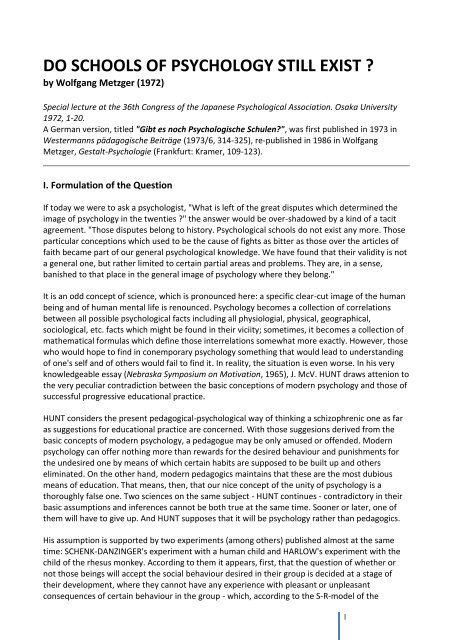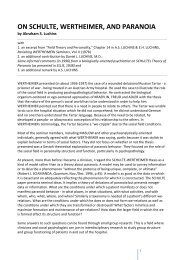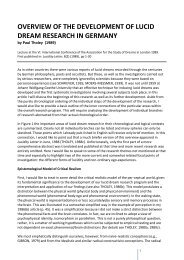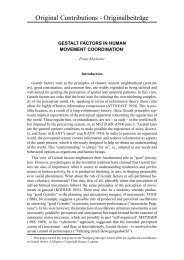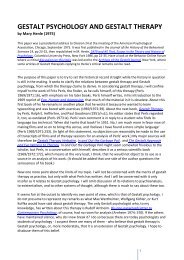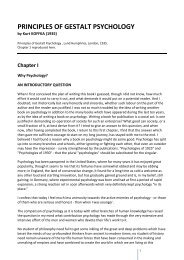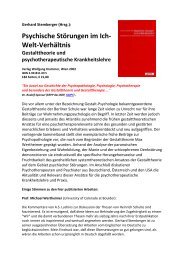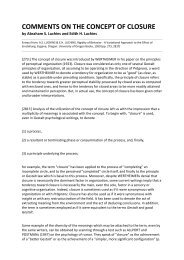pdf-Download - Society for Gestalt Theory and its Applications (GTA)
pdf-Download - Society for Gestalt Theory and its Applications (GTA)
pdf-Download - Society for Gestalt Theory and its Applications (GTA)
You also want an ePaper? Increase the reach of your titles
YUMPU automatically turns print PDFs into web optimized ePapers that Google loves.
DO SCHOOLS OF PSYCHOLOGY STILL EXIST ?<br />
by Wolfgang Metzger (1972)<br />
Special lecture at the 36th Congress of the Japanese Psychological Association. Osaka University<br />
1972, 1-20.<br />
A German version, titled "Gibt es noch Psychologische Schulen?", was first published in 1973 in<br />
Westermanns pädagogische Beiträge (1973/6, 314-325), re-published in 1986 in Wolfgang<br />
Metzger, <strong>Gestalt</strong>-Psychologie (Frankfurt: Kramer, 109-123).<br />
I. Formulation of the Question<br />
If today we were to ask a psychologist, "What is left of the great disputes which determined the<br />
image of psychology in the twenties ?" the answer would be over-shadowed by a kind of a tacit<br />
agreement. "Those disputes belong to history. Psychological schools do not exist any more. Those<br />
particular conceptions which used to be the cause of fights as bitter as those over the articles of<br />
faith became part of our general psychological knowledge. We have found that their validity is not<br />
a general one, but rather limited to certain partial areas <strong>and</strong> problems. They are, in a sense,<br />
banished to that place in the general image of psychology where they belong."<br />
It is an odd concept of science, which is pronounced here: a specific clear-cut image of the human<br />
being <strong>and</strong> of human mental life is renounced. Psychology becomes a collection of correlations<br />
between all possible psychological facts including all physiologial, physical, geographical,<br />
sociological, etc. facts which might be found in their viciity; sometimes, it becomes a collection of<br />
mathematical <strong>for</strong>mulas which define those interrelations somewhat more exactly. However, those<br />
who would hope to find in conemporary psychology something that would lead to underst<strong>and</strong>ing<br />
of one's self <strong>and</strong> of others would fail to find it. In reality, the situation is even worse. In his very<br />
knowledgeable essay (Nebraska Symposium on Motivation, 1965), J. McV. HUNT draws attenion to<br />
the very peculiar contradiction between the basic conceptions of modern psychology <strong>and</strong> those of<br />
successful progressive educational practice.<br />
HUNT considers the present pedagogical-psychological way of thinking a schizophrenic one as far<br />
as suggestions <strong>for</strong> educational practice are concerned. With those suggesions derived from the<br />
basic concepts of modern psychology, a pedagogue may be only amused or offended. Modern<br />
psychology can offer nothing more than rewards <strong>for</strong> the desired behaviour <strong>and</strong> punishments <strong>for</strong><br />
the undesired one by means of which certain hab<strong>its</strong> are supposed to be built up <strong>and</strong> others<br />
eliminated. On the other h<strong>and</strong>, modern pedagogics maintains that these are the most dubious<br />
means of education. That means, then, that our nice concept of the unity of psychology is a<br />
thoroughly false one. Two sciences on the same subject - HUNT continues - contradictory in their<br />
basic assumptions <strong>and</strong> inferences cannot be both true at the same time. Sooner or later, one of<br />
them will have to give up. And HUNT supposes that it will be psychology rather than pedagogics.<br />
His assumption is supported by two experiments (among others) published almost at the same<br />
time: SCHENK-DANZINGER's experiment with a human child <strong>and</strong> HARLOW's experiment with the<br />
child of the rhesus monkey. According to them it appears, first, that the question of whether or<br />
not those beings will accept the social behaviour desired in their group is decided at a stage of<br />
their development, where they cannot have any experience with pleasant or unpleasant<br />
consequences of certain behaviour in the group - which, according to the S-R-model of the<br />
1
classical learning theory, is the necessary condition <strong>for</strong> the appropriation of suitable patterns of<br />
social behaviour - because they are still hanging on the breast of their mothers. Second, there has<br />
not been, as yet, a successful attempt to return an uncared-<strong>for</strong> to the path of virtue, i.e., back to<br />
the desired social behaviour, by punishing his undesired behaviour <strong>and</strong> rewarding the desired one.<br />
To this end, quite different measures are needed, as we may read - to name only the sources on<br />
h<strong>and</strong> - in the classical studies of AICHHORN, <strong>and</strong> also in the works of Alfons SIMON <strong>and</strong> H.<br />
FÜLLIGER.<br />
However, is it really so bad with psychology? Is the S-R-scheme, including the modifications<br />
introduced by passive <strong>and</strong> active conditioning, really all that psychology has to offer <strong>for</strong> the<br />
solution of educational problems? This question is parallel with that of the unity of psychology,<br />
i.e., with whether there are really no more differing conceptions <strong>and</strong> schools in psychology. Should<br />
the answer be affirmative, it would be necessary - to cope with the knowledge <strong>and</strong> needs of the<br />
pedagogues - to invent immediately a new psychology which would correspond better to the<br />
reality of man.<br />
Moreover, an affirmative answer would mean that psychology is no longer a young, vital,<br />
progressive science, as such sciences are characterized by continuous emerging of new problems<br />
bringing about the most contradictive assumptions or hypotheses. And it is an age-old experience<br />
that one of the most significant driving powers of progress is the ef<strong>for</strong>t to find among these<br />
contradictory assumptions the correct one. The notion "assumption" or "hypothesis" should not<br />
be understood here in the diluted sense of statistical lingo where it means only one of several<br />
possible outcomes of a situation, which - if it does not come true - is "rejected". This notion means<br />
something more to us : a not yet or not yet sufficiently proved assumption concerning a more or<br />
less broad scope of functional relations, in about the sense in which the notion "model" is<br />
understood today, but without the presently much advocated meaning that only a mathematical<br />
<strong>for</strong>mulation makes a full-fledged model out of a hazy idea. (See also DROESLER, Congress in<br />
Vienna, Symposium on Perception.) Thus, we underst<strong>and</strong> the notion "hypothesis" in the old sense,<br />
as a statement, which could be promoted to the status of a theory by sufficient experimental<br />
proof.<br />
Of course, there will always be hypotheses of very different ranges. And only in those cases where<br />
the hypotheses had a sufficient range, a sufficiently broad area of validity, a basic significance, was<br />
it customary to speak about a "school", especially when it advocated several different, logically<br />
independent but "matching" hypotheses at the same time.<br />
Thus, the question appears to be as follows: are there still some differences in the opinions<br />
concerning the basic questions in psychology ?<br />
II. The Principles of Contemporary Psychology<br />
Let us take, as our first example, orthodox behaviourism, as it was represented, <strong>for</strong> example, by<br />
SKINNER, because it is widely considered the psychology of the present time (also by HUNT).<br />
Analysis shows that it is built up of about a dozen principles conceived by the prominent<br />
representatives of the school as axioms or articles of faith. However, they might be nothing more<br />
than unproved hypotheses.<br />
1. The Principle of Objectivity<br />
2
Only data which can be observed <strong>and</strong> recorded from outside may be used in psychoogy if it is<br />
supposed to be scientific psychology. Psychology can cope with <strong>its</strong> ambition to be an empirical<br />
science only as a science of behaviour.<br />
This is not a hypothesis concerning the facts of psychology; rather, it is a methodic rule, or, more<br />
clearly, a prohibition to evaluate certain data because of their lack of reliability.<br />
2. The Principle of Passivity or of Primary Reactivity<br />
The psycho-physical organism starts to function only because of external influence. Thus, the<br />
objective of the science of behaviour is to assess the relations between the influences from<br />
outside (stimuli or situations, "S") <strong>and</strong> the reactions towards the outside world (responses, "R"),<br />
i.e., the "S-R-relation". The reactions R, bring about a mostly new situation resp. a new kind of<br />
influence S2; thus, the elementary relation as a whole may be symbolized as S1-R-S2.<br />
3. The Principle of Genetic Identity of Psycho-physical Systems<br />
The hereditary or innate psychic outfit is the same <strong>for</strong> all men, if not <strong>for</strong> all verebrata. There<strong>for</strong>e,<br />
<strong>for</strong> experimental research of human behaviour, doves or rats may be used.<br />
4. The Principle of Minimum Genetic Outfit (of Tabula Rasa)<br />
Without taking into account some elementary reflexes, there are no hereditary relations between<br />
the influences S <strong>and</strong> the reactions R. All differences in reactions R are the result of previous<br />
differences in the surroundings S (i.e., S from birth till the respective moment): milieu theory or<br />
environmentalism. What a person knows, he has learned during his individual existence. The<br />
capability of learning is the basic property of the psychic. Theoretical psychology is basically a<br />
theory of learning.<br />
Principles (3) <strong>and</strong> (4) <strong>for</strong>m together the doctrine called empiricism since the 18th century.<br />
5. The Principles of Elementarism <strong>and</strong> Connectionism<br />
Learning is a process of <strong>for</strong>mation of connections between elementary facts, of in<strong>for</strong>cement of<br />
such connections or of weakening or extinction of connections already existing.<br />
6. The Principle of Contiguity (Principle of Contact)<br />
The decisive condition <strong>for</strong> any connection is time-space vicinity, if possible, repeated many times.<br />
7. The Principle of Contingency of Arbitrariness<br />
There is no principle of connection <strong>for</strong>mation but <strong>for</strong> that of contingency; that means that chance<br />
or an arbitrary decision of the experimenter is the only decisive factor. The factual pertinency<br />
("matching", "mutual dem<strong>and</strong>edness") of the facts to be connected plays no role.<br />
Thus, no distinction is made between the attainment of a (desired) goal on one side (e.g., of a<br />
correct solution of a problem by following, without error, some suitable proceedings) <strong>and</strong> getting<br />
a pleasant reward (a piece of c<strong>and</strong>y) as a result of observing an arbitrary (prescribed by the<br />
experimenter) behaviour on the other side.<br />
3
The principles (5), (6) <strong>and</strong> (7) <strong>for</strong>m together the so-called "associationism". From the beginning<br />
they have also been the principal rules of empiricism (principles (3) <strong>and</strong> (4)). The new<br />
associationism differs - because of principles (1) <strong>and</strong> (2) - from the old one in that it deals with<br />
connections of situations S with reactions R (passive conditioning), rather than with connections<br />
between contents of consciousness ("ideas").<br />
8. The Machine Principle<br />
There are an older <strong>and</strong> a new version of the assumptions concerning the relations between<br />
situations <strong>and</strong> reactions; incidentally, they do not exclude each other.<br />
a) The older one is the automation model. It is divided - according to the assumptions about the<br />
energy sources - into two subtypes:<br />
a1 - The conduction or telephone network type: the stimulus S penetrates as an impulse through a<br />
receptor cell into the nervous system <strong>and</strong> there it proceeds - because of the central network of<br />
connections - to the effector organ where it leaves the organism as the reaction R.<br />
a2 - The trigger type: the stimulus S acts - like a pressure on a push-button or a dime dropped in<br />
the slot - as a trigger which releases a ready-to-work but, until the moment of stimulation, blocked<br />
mechanism; then, the mechanism starts to work with <strong>its</strong> own energy.<br />
b) According to the newer concept of the homeostatic or tension-reduction model (borrowed<br />
from CANNON), the stimulus S disturbs the equilibrium state of an organ system, <strong>and</strong> the reaction<br />
R restores it again. The needs are just these disturbances of equilirium or increases of tension, <strong>and</strong><br />
the gratification of a need is just this reduction of tension. (Von BERTALANFFY calls all three<br />
variants together "the robot model of man".)<br />
As it was shown by W. KÖHLER, the notion of homeostatic processes with their necessary feedbacks<br />
already exceeds the limitations of the classical machine principle, as the process may affect<br />
<strong>its</strong>elf at least at one single spot. though by means of special conductive connections.<br />
According to the tension-reduction model the psycho-physical system seeks under all<br />
circumstances a quiet state. This model may there<strong>for</strong>e be understood as an expresion of the<br />
principle of quietism: all activity is the result of disturbances <strong>and</strong> "sweet leisure" is the normal<br />
state of man.<br />
9. The Principles of Chance <strong>and</strong> Effect<br />
In order to underst<strong>and</strong> the <strong>for</strong>mation of new connections <strong>and</strong> the extinction of existng ones, as in<br />
passive ("classical" PAVLOVian) conditioning, no new principle is needed, as conditioning is but<br />
another name <strong>for</strong> association introduced <strong>for</strong> the special case in which one of the elements to be<br />
connected is an activity of the subject.<br />
If new types of per<strong>for</strong>mance are needed as in trial <strong>and</strong> error learning resp. operant or instrumental<br />
conditioning, these can - as a consequence of principle 7 - only be found by chance <strong>and</strong> recognized<br />
as suitable <strong>and</strong> retained by their effect.<br />
10. The Principle of Additivity of Personality Structure<br />
4
The S-R-connections rein<strong>for</strong>ced by success-failure learning are also called hab<strong>its</strong>. Personality or<br />
character is the sum of hab<strong>its</strong>. Any of these hab<strong>its</strong> may be induced or eliminated individually<br />
without changing anything in all other hab<strong>its</strong> (vegetable bed model). From these ideas of<br />
<strong>for</strong>mation <strong>and</strong> elimination of hab<strong>its</strong> results immediately the old, traditional, but, by modern<br />
pedagogics, rejected practice of "c<strong>and</strong>y <strong>and</strong> whip". As the desirability or undesirability is<br />
determined by the educating society, the result of such an education is the maximum obtainable<br />
degree of adaptation (adjustment) or the con<strong>for</strong>mity, in other words, opportunism.<br />
11. The Principle of Reductionism<br />
There are no autochthonous psychic dynamics. All dynamics, e.g., that of learning, of thinking, of<br />
exploring, serves the purpose of decreasing organismic tensions. He, who is not hungry, does not<br />
think.<br />
12. In the area of social psychology, reductionism results in: The Principle of Primary Social<br />
Atomism<br />
There are no primary social needs <strong>and</strong> desires. They are only secondarily <strong>for</strong>med by conditioning,<br />
i.e., by the realization that certain persons are exceptionally suitable tools or means <strong>for</strong> the<br />
gratification of certain organismic needs <strong>and</strong>/or <strong>for</strong> the reduction of certain organismic tensions.<br />
In this respect, there is an unanimity between behaviurism <strong>and</strong> psychoanalysis.<br />
III. Axioms or Hypotheses?<br />
A question arises here: are the above principles axioms, i.e., necessary presumpions of any<br />
psychology, or are they hypotheses, which - in the present state of the science - would have to<br />
permit the existence of other hypotheses <strong>and</strong> eventually - perhaps even now - give way to them;<br />
in other words, are there still opposite schools in psychology ? Thus, our question is: are the above<br />
principles necessary: And, in addition, are they sufficient ?<br />
1. On the Principle of Objectivity<br />
The principle of subjectivity cannot be considered an alternative to the objectivity principle. It<br />
characterizes a historical phase of psychology which continued until the introduction of<br />
behaviourism. As the objectivity principle is a prohibition, the alternative would be a psychology<br />
without this prohibition. This alternative is realized in phenomenological psychology, in "<strong>Gestalt</strong><br />
theory" <strong>and</strong> in a number of other approaches of present psychology, <strong>and</strong> - as we shall see - it is<br />
successful.<br />
Incidentally, behaviourism <strong>its</strong>elf - even at <strong>its</strong> extremes - disregarded <strong>its</strong> own prohibition from the<br />
moment it started to speak about the "concealed", "internal", "preceding", "behaviour", meaning<br />
processes which cannot be registered by physiological means, but which are rather unequivocally<br />
identical with the acts <strong>and</strong> contents of subjective psychology. The confession of having given up a<br />
principle which played a fundamental role in the establishment declaration of behaviourism is, of<br />
course, embarrassing. However, it is even more embarrassing that this ab<strong>and</strong>onment of a basic<br />
principle not only was not confessed but rather veiled by semantic manipulations, by adding to the<br />
names of these subjective facts the suffix "behaviour".<br />
5
Thus, a psychology without the principle of objectivity is not only possible but rather inevitable.<br />
That is why we have a new variant of behaviourism calling <strong>its</strong>elf "subjective behaviourism" (G.A.<br />
MILLER, E. GALANTER, K.H. PRIBRAM, 1960). The adjective, of course, inevitably annuls the only<br />
clear denotation of the word "Behaviourism" as a non-subjective psychology.<br />
2. On the Principle of Primary Reactivity<br />
Here, also, the alternative is not a concept of a psycho-physical organism characterized by<br />
exclusively spontaneous activity; the true alternative is an organism capable as well of<br />
spontaneous activity as of re-action, <strong>and</strong>, in which, in many cases the re-active behaviour patterns<br />
are only superposed on the primary spontaneous ones.<br />
As it was proven by COGHILL, the first movements of the amblystomic larva are spontaneous<br />
because they occur at a stage of development when the receptor nerves do not yet have<br />
connections with the motor centers. The same was shown by von HOLST, e.g., that the rhythmiclocomotor<br />
fin movements of the fish are not triggered <strong>and</strong> maintained by external stimuli <strong>and</strong> that<br />
these stimuli only modify them. Behaviour in play <strong>and</strong> in exploration goes also beyond the lim<strong>its</strong> of<br />
the S-R-scheme, as the opporunity <strong>for</strong> it is looked <strong>for</strong> even by animals <strong>and</strong> as it immediately starts<br />
anew after each conclusion, i.e., after each reduction of tension.<br />
In this case as well, the unavoidable necessity to accept these facts is veiled by behaviourists by a<br />
notorious renaming manoeuvre: in the place of the objectively observable - that means originally<br />
unequivocally external triggering situation S (with respect to the organism) - simply a nonobservable<br />
inner-organismic environment of the motor centers is introduced; <strong>and</strong> it appears as if<br />
the meaning of the term reaction had not been changed.<br />
Anyway, a psychology rejecting the principle of primary reactivity is not only possible, but rather<br />
required by the facts.<br />
3. On the Principle of Genetic Identity<br />
The principle of genetic identity of psycho-physical systems is identical with the denial of specific<br />
inborn tra<strong>its</strong>. Here also, the alternative would not be a psychology which would try to reduce all<br />
differences in the behaviour of different individuals to the differences of the predispositions, but<br />
rather a psychology that would avoid dogmatic presuppositions with regard to the contribution of<br />
genetic <strong>and</strong> environmental factors to individual differences.<br />
As to the validity of this principle <strong>for</strong> all vertebrata, this was clearly refuted by an abundance of<br />
results of recent comparative behavioural research, obtained under pure conditions, e.g., in the<br />
Kasper-Hauser experiment.<br />
As to the differences in human psycho-physical genetic outfit, no basic doubts exist any more. The<br />
existing controversy pertains only to the relative effects of innate outfit <strong>and</strong> of environment.<br />
In spite of all this, behaviourism is still stuck with the principle of genetic identity. This is a result of<br />
an attitude that is even less scientific than the method of renaming, namely simply ignoring all<br />
facts not corresponding to one's principles (See K. LORENZ 1961).<br />
6
Altogether, it appears that a psychology without the principle of genetic identity is not only<br />
possible, but - in the face of the existing facts - necessary.<br />
4. On the Principle of Genetic Minimum Outfit<br />
In the discussion of this principle it is necessary to take into account the fact that the principle of<br />
objectivity was already rejected by behaviourism <strong>its</strong>elf (see above). The most significant<br />
arguments against the minimum outfit principle are derived from the subjective sphere.<br />
In contrast to the tabula rasa approach, all sensual data enter<br />
a) an already existing <strong>and</strong> unchangeable system of dimensions - not more <strong>and</strong> not less than three<br />
space- <strong>and</strong> one time-dimension. Moreover, sensual data are limited to a system of elementary<br />
qualities already existing. Interestingly, this system may differ between individuals in a clearly<br />
definable way according to their basic outfit (DALTONism).<br />
b) the bulk of the sensual data is divided <strong>and</strong> grouped spontaneously in accordance with a given<br />
system of categories.<br />
c) this grouping is distributed all over the three given space dimensions according to the minimum<br />
<strong>and</strong>/or optimum principles (Prägnanz-tendencies) which are inherent to the system <strong>and</strong> not<br />
modifiable by individual experience, thus only partially accord- ing to experience, but partially<br />
defying experience. (See among others, E. MACH, W. METZGER, G. KANIZSA).<br />
The facts a), b) <strong>and</strong> c) are not consequences of experiences, but rather conditions which make it<br />
possible to acquire any experience; they are "pre-empirical".<br />
The principle of reaction patterns inherent to the system is not to be confused with the principle<br />
of nativism. Nativism maintains only - in contrast to empiricism - that adjustment to reality is in<br />
certain aspects reached phylogenetically rather than ontogenetically. It does not mention systemspecific<br />
reaction patterns at all. Moreover, there are in the case of animals, many <strong>and</strong>, in the case<br />
of men, at least several strucures originating from the above laws, without any previous<br />
experience resp. success <strong>and</strong> error learning with biologically specific releasing functions. These<br />
cannot be under- stood without admitting some analogon of the much abused "idea innata". (The<br />
English expression IRM - innate releasing mechanism, as well as the German AAM - angeborener<br />
ausloesender Mechanismus, adequately reflect these facts only in their first two words, but the<br />
word "mechanism" is misleading <strong>and</strong> should be replaced by the word "cue", in German<br />
"Merkmal").<br />
All this means that the principle of genetic minimum outfit is not consistent with the facts. Thus, a<br />
psychology without this principle is not only possible but rather necessary.<br />
5. On the Principles of Elementarism <strong>and</strong> Connectionism<br />
Under the assumption that the principle of objectivity is rejected, it becomes necessary to discuss<br />
the above two principles with a view to the three following problems:<br />
1) The problem of autonomous motions (motorics)<br />
2) The problem of the surrounding world (situations)<br />
7
3) The problem of the relation between the situation <strong>and</strong> motorics, which is the basis of<br />
behaviour.<br />
The alternative to the statement that all larger complexes in the psychological sphere result from<br />
the connection of elementary facts is not the statement that, in the psychic life, "everything is<br />
interconnected" at the beginning <strong>and</strong> that, only in time, by means of maturation <strong>and</strong> learning<br />
processes, this universal interconnection is gradually split up <strong>and</strong> resolved (William JAMES, Hans<br />
CORNELIUS, Felix KRUEGER, Heinz WERNER).<br />
The alternative is rather an assumption that the development <strong>and</strong> learning proesses :<br />
a) split up <strong>and</strong> resolve existing larger complexes,<br />
b) combine existing small complexes, which, in extreme cases, may have the character of<br />
elements, into larger complexes, <strong>and</strong><br />
c) that existing structures may change into others by simultaneous resolving <strong>and</strong> reombining.<br />
In such a psychology, too, the question arises as to whether one of these processes is primary <strong>and</strong>,<br />
if this is the case, which one. Here only the following is certain:<br />
1) in the sphere of motorics, the primary process of development is the process a), the splitting or<br />
differentiation of the originally total motion patterns which employ all available muscles,<br />
(COGHILL).<br />
2) similarity, in establishing the structure of the surrounding world, the primary one is not the<br />
problem of combining "un<strong>its</strong>" but rather that of establishing boundaries, that means, again, the<br />
problem of differentiation.<br />
3) on the other h<strong>and</strong> - at least in the case of man - the secondary connection between situations<br />
<strong>and</strong> activities in the sense of behaviourism seems to be the more frequent or perhaps the main<br />
means of change even when, as the possibility of extinction of existing connections proves, not the<br />
only one.<br />
6. On the Principle of Contiguity or Contact<br />
Contact or time-space vicinity is an important but neither a sufficient nor necessary condition <strong>for</strong><br />
the <strong>for</strong>mation of connections.<br />
It is not sufficient. The perception field is a continuum without gaps. Thus, the problem arising<br />
here may be verbalized in the following way: how is it possible that two processes A, B, taking<br />
place in an immediate contact with each other, <strong>for</strong>m a unity whereas two processes B, C, taking<br />
place in an immediate contact with each other as well differentiate from each other. Apparently,<br />
other principles must be involved.<br />
The same as has been said about the primary field differentiation may be repeated in the case of<br />
association experiments. Under completely identical time-space conditions, very different<br />
numbers of repetitions are needed in order to establish a connecion independent of the materials<br />
which are to be connected. In addition, the durability of such connections is very different. Even in<br />
this case it is not possible to speak of an exclusive effectiveness of the space-time factor.<br />
8
On the other h<strong>and</strong>, the space-time vicinity is not necessary. In problem solving processes, the facts<br />
which are "required" in order to fill in a specific gap are often brought from a considerable<br />
distance. This does not always happen through an active search but frequently results immediately<br />
from the dynamics of the process.<br />
7. On the Principle of Contingency or of Arbitrariness<br />
What is missing in the principle of time-space vicinity <strong>for</strong> the explanation of the primary field<br />
differentiation is provided <strong>for</strong> by the principle of non-arbitrariness of the connections. The<br />
connections <strong>and</strong> differentiations occur unequivocally according to optimum <strong>and</strong>/or minimum<br />
conditions. (METZGER, 1966).<br />
On the other h<strong>and</strong>, the animal <strong>and</strong> human nervous systems, beyend the primary field<br />
differentiation, have a very remarkable capacity to <strong>for</strong>m <strong>and</strong> preserve completely arbitrary<br />
(accidental or deliberately chosen) connections, <strong>for</strong> instance, that of a person <strong>and</strong> a name or of a<br />
name <strong>and</strong> a telephone number, apparently on the grounds of a mere "togetherness".<br />
Ceteris paribus, however, between the meaningless <strong>and</strong> meaningful connections, there exists a<br />
remarkable difference in the ease of their establishment, <strong>and</strong> in the stability of their preservation.<br />
Here, the expression "meaningful" has two denotations:<br />
a) one of the facts may be an image of the other one (e.g., series of numbers <strong>and</strong> series of dig<strong>its</strong><br />
on a dial) or it has similar or corresponding "general properties".<br />
b) one of the facts is "missing" in the other one - it is "required" by the other one. By <strong>its</strong><br />
introduction, a "complete" whole of a uni<strong>for</strong>m lawful structure is <strong>for</strong>med (WERTHEIMER, 1945).<br />
The furthering effects of consistency holds according to everyday experience <strong>for</strong> the S-R-relation<br />
as well. This, naturally, is to be assessed by further systematic research.<br />
As it appears in a more precise analysis, the multiplicity of the behavioural patterns produced<br />
during the first phase of the trial <strong>and</strong> error process is in no way, as mainained, arbitrary with<br />
regard to the sought goal. Rather, from the infinite multitude of possible behavioural patterns, a<br />
choice is made in the sense of an - at least seeming - goal relevance, i.e., in the sense of preferring<br />
those actions which promise, because of their character, the possibility of attaining the goal.<br />
All in all, a psychology in which the principles of contiguity <strong>and</strong> contingence would be banished to<br />
a more modest place which is proper <strong>for</strong> them is possible as well as required by the facts.<br />
8. On the Question of the Machine Character of the Relations between Situations <strong>and</strong> Reactions<br />
As shown above, behaviourism has three different models of this relation - two strictly<br />
mechanistic, <strong>and</strong> one with dynamic properties. The mechanistic models are:<br />
a) The conduction <strong>and</strong> switching model (telephone network type)<br />
b) The release mechanism model (trigger type)<br />
The quasi-dynamic one is the homeostatic model.<br />
9
According to the first two models, the organism is an aggregate of mechanisms, according to the<br />
third one, an aggregate of (normally) idle subsystems with feedback connections, remaining in a<br />
state of rest unless their equilibrium is disturbed. The aggregate structure is characteristic of all<br />
three models. Further, all three models maintain that a psycho-physical organism, if not<br />
stimulated, is in a quiet state which is changed by stimulation into activity only <strong>for</strong> a limited time.<br />
In the first <strong>and</strong> second case, this reflects the fact that the psychic subsystems are considered<br />
mechanisms ready <strong>for</strong> eventual use, in the third case, that the equilibrium state of the subsystems<br />
is understood as a static equilibrium.<br />
However, there is a fourth possibility, the most probable one (taking into account the fact that the<br />
psycho-physical processes take place in a living organism). It has two complementary assumptions:<br />
a) Not only within the subsystems of the psycho-physical system there exists a dynamic relation<br />
between their elements. Such a relation also exists between the different subsystems themselves<br />
<strong>and</strong> between the total psycho-physical system <strong>and</strong> the rest of the organism as well. Thus, there<br />
exists a highly complicated system of highly sensitive equilibriums with a hierarchy of smaller <strong>and</strong><br />
larger areas.<br />
b) As to these equilibria, they are not static. Rather, in each point of the system, there constantly<br />
exists a characteristic static disequilibrium which preserves certain active processes. In physics<br />
these processes are called stationary or quasi-stationary processes. Ludwig von BERTALANFFY<br />
introduced the simple expression "steady states".<br />
That means, however, that the organismic subsystems are constantly active. Thus, the "stimulus" S<br />
does not cause the activity of the organism; as a change in the conditions surrounding the<br />
organismic system, it only modifies an already existing activity. This was already supposed by E.<br />
HERING (in his Chromology). Wolfgang KÖHLER, proceeding from an idea of Max WERTHEIMER<br />
(1922), proved in the year 1920-22 that this supposition is in accordance with the current ideas of<br />
physics <strong>and</strong> used it in his theory of perception. Ludwig von BERTALANFFY, proceeding from<br />
biological facts <strong>and</strong> ideas, showed the basic significance of the steady state. E. von HOLST, in his<br />
theory of position reflexes, strictly proved the fact of continuous activity of the nervous system<br />
modified only by external conditions.<br />
Static equilibriums <strong>and</strong> steady states have one characteristic in common. Both tend towards<br />
structurally defined, time-independent, final state, determined solely by the parameters of the<br />
system, <strong>and</strong> thus independent of the initial conditions. These final states are established or reestablished<br />
(in case of disturbances) in different ways according to the initial conditions. Thus, the<br />
entire process achieves a character of finality withut defying natural laws.<br />
Moreover, systems preserving a steady state have some properties which are missing in the<br />
systems tending towards a static equilibrium only. The processes which enable a system in a<br />
steady state to stay in it take materials from the surroundings of the system, <strong>and</strong>, with them,<br />
"negative enthropy". There is another fact which is connected with this which was shown by W.<br />
KÖHLER <strong>and</strong> Ludwig von BERTALANFFY in independent works. They have a capability of transition<br />
into states of higher complexity <strong>and</strong> regularity, into states of higher order, <strong>and</strong>, that means of<br />
lower enthropy. Thus, they behave seemingly in defiance of the second law of thermodynamics.<br />
This holds true not only <strong>for</strong> the development of more <strong>and</strong> more highly organized beings in the<br />
course of phylogenesis <strong>and</strong> <strong>for</strong> the development of a mature organism from the fertilized ovum<br />
10
(morphogenesis), but also <strong>for</strong> the productive psychic processes. Apparently, they do not take their<br />
energy from the external surroundings, like the whole organism, but rather from the psychic<br />
surrounding field, from the psychic neighboring systems, so that, in the limit case of a (sound)<br />
obsession by a (scientific, artistic, technological, organizational) problem, these neighboring<br />
systems may become deprived of energy <strong>and</strong> the respective man, as it were, "consumes himself"<br />
(W. KÖHLER). In other words, during these processes, the dynamics of the gratification of<br />
elementary needs may become more or less <strong>and</strong>, at least <strong>for</strong> a certain time, the less significant<br />
one.<br />
This dynamic approach to the relation between the situation <strong>and</strong> reaction allows clarification not<br />
only of the facts which were already explained in another way by behaviourism, but also of two<br />
basic psychological facts which were not explained by behaviourism: finality <strong>and</strong> productivity.<br />
The fact that this not so simple idea was founded on the basis of both objective (von<br />
BERTALANFFY, von HOLST) <strong>and</strong> subjective data (KÖHLER, WERTHEIMER) indicates that the denial<br />
of scientific usefulness of subjective data (the first principle of behaviourism) was aparently based<br />
on insufficient facts. By the way, both "subjective data" (Sign-gestalt) <strong>and</strong> finality is admitted in the<br />
"purposive behaviourism" (TOLMAN, 1932).<br />
9. On the <strong>Theory</strong> of Learning by Success<br />
According to the behaviouristic theory of learning, it may be ascertained only on the basis of a<br />
success arrived at already whether some behaviour approaches the goal or not (if there are no<br />
previously acquired mechanisms or behaviour patterns).<br />
But, there are certain problem situations, natural or deliberately introduced, which are so<br />
accidental or so unclear that there is no other possibility in coping with them but <strong>for</strong> the classical<br />
active conditioning. However, here the question arises as to whether the conditioning may serve<br />
as a model <strong>for</strong> all possible problem solving processes. If this should be correct, then the basic<br />
principle would be as follows: There is no primary finality in the behaviour of living beings. This<br />
thesis cannot bs valid, as was demonstrated in the preceding paragraph. Wolfgang KÖHLER in his<br />
intelligence tests of anthropoids was successful in 1917 in proving the primarily goal-centered<br />
behaviour in new situations without any ready behavioural patterns available. As to the primary<br />
finality of the productive mental processes of man, see, first of all, Max WERTHEIMER, 1945.<br />
The constantly reappearing assertion that the insightful solving of problems occurs "in reality"<br />
through trial <strong>and</strong> error, <strong>and</strong> that it is only transferred from exterior to interior (to imagination, or,<br />
in the behaviouristic nomenclature, on the "hidden level") has never been proven as yet <strong>and</strong>,<br />
preserving the principle of objectivity, cannot be proven at all.<br />
Replacing overt trials by the assumption of "internal" attempts, "preceding" the external<br />
behaviour, misses the essential. First, if a person decides to go to the right around a big round<br />
table to reach his goal <strong>and</strong> not to the left, he does not need to try both possibilities in his<br />
imagination in order to find out that it takes a couple of steps less if he goes to the right. Rather,<br />
he can observe in his surrounding world that the way to the right is shorter. Second, even<br />
intelligent problem solving is often not possible without (external) attempts. However (<strong>and</strong> this is<br />
the decisive point), whereas according to learning theory, one of the attempted activities must<br />
have already succeeded in order to be recognized, accepted <strong>and</strong> memorized as useful, in reality,<br />
<strong>for</strong> an intelligent, primarily goal-centered activity it is characteristic that it displays choice of<br />
11
attempts limited apriori by a view to the goal <strong>its</strong>elf. But, moreover, in a typical case of an external<br />
attempt, as it can possibly occur even in the course of intelligent problem solving, long be<strong>for</strong>e<br />
success or failure are arrived at, it is possible to recognize whether or not it serves the desired use.<br />
Blind trials of any activities in the sense of the behaviouristic theory of learning are thus possible<br />
<strong>and</strong> sometimes unavoidable. But in no way are blind trials the only or even only preferred way of<br />
problem solving.<br />
10. On the Principle of Additivity in the Development of Personality<br />
W. KÖHLER <strong>and</strong> L. von BERTALANFFY proved half a century ago that, besides the vegetables bed<br />
model of personality as presented by the behaviouristic theory of learning, another model is<br />
possible, i.e., the model of a very complex open system with a hierarchy of interrelated<br />
subsystems, in full accordance with known natural laws. In the light of our present knowledge of<br />
the processes in living organisms, this model is even more probable. It is an important<br />
characteristic of such a system that it shows reactions which cannot be understood on the basis of<br />
a local disturbance (failure of a certain apparatus) but rather on the basis of a disturbance of the<br />
general system equilibrium, <strong>and</strong> which are there<strong>for</strong>e to be h<strong>and</strong>led accordingly. The<br />
psychoanalytic concept of neuroses, with all that it has in common with S-R-psychology, is, in this<br />
respect, clearly in accord with the system theory from the very beginning.<br />
In the framework of the new theories <strong>and</strong> models, it was possible to establish aproaches to the<br />
process of education which surpass the dubious reward-punishment model. To this, we shall<br />
return later.<br />
11. On the Principle of Reductionism<br />
It is a common observation that a living being sometimes stresses <strong>its</strong> psychic capailities just to get<br />
some food under unfavourable conditions, i.e., just to gratify an elementary (organismic) tension.<br />
However, the assertion that all psychic activity serves only to gratify elementary tensions <strong>and</strong>, in<br />
the psychoanalytic version, to subjectively gratify the achievement of local pleasant feelings,<br />
contradicts the facts observed not only in the case of great thinkers, scientists, inventors <strong>and</strong><br />
organizers, but even in the case of an animal exploring new surroundings or a playing child. The<br />
tension of an unsolved problem <strong>and</strong> the restless activity which it induces in a scientist or in an<br />
artist, as well as in an interested student <strong>and</strong> in a rat transferred to unknown surroundings, on the<br />
grounds of immediate observations is to be considered as just as elementary as the tension of<br />
hunger or of the sex drive. Moreover, this may be conceived theoretically as well on the basis of<br />
the facts given in paragraph.<br />
The question as to whether the tension resulting in a mental ef<strong>for</strong>t is an autochtho- nous one or<br />
whether it is induced by elementary needs, or whether both occur simulaneously, is thus not a<br />
question of the principle but rather a factual one <strong>and</strong> it can be answered only <strong>for</strong> this or that<br />
actual case. In paragraph 8, it was shown that the energy <strong>for</strong> elementary needs may be consumed<br />
by mental interests. What happens here sometimes is in a way similar to the FREUDian<br />
"sublimation". However, the dynamic relation differs. Whereas in FREUD's concept the block of<br />
normal gratification of the accumulated drive energy results in a mental activity, in the model of<br />
the open system the opposite appears. An intensive mental activity absorbes the energy available<br />
in the neighboring systems like fire absorbes the air with which it grows <strong>and</strong> preserves <strong>its</strong>elf.<br />
12. On the Principle of Primary Social Atomism<br />
12
Primary social atomism is, as has been shown already, a subspecies of reductionism. Behaviourism<br />
<strong>and</strong> pychoanalysis agree here again. In the latter, it is expressed even more clearly in the<br />
description of the "Erogenous zones" which are supposed to be the main gratification areas in<br />
early infancy, in labeling the other man as an "object" of the drive, i.e., as the tool of the primary<br />
body-centered gratification, <strong>and</strong> in that it considers the organism as the main source of<br />
gratification so that other people are not indispensable even as tools.<br />
Again, the question arises: is there an alternative ? This question can be divided in the following six<br />
sub-questions:<br />
1) Are there some primary <strong>and</strong>, at the same time, vital social needs?<br />
2) Have other people <strong>and</strong> beings who <strong>for</strong>m groups together with the Ego really the psychological<br />
character of tools serving the Ego, or are they possibly, <strong>for</strong> a normal human being, of the same<br />
psychological relevance <strong>and</strong> of the same significance as the Ego, <strong>and</strong>, under some conditions,<br />
possibly even of greater importance ?<br />
3) Are the social structures in the framework of which the individual exists <strong>and</strong> lives realities of the<br />
same relevance as his own Ego ?<br />
4) Is the way in which the individual participates in his group relevant to his manner of general<br />
behaviour, first of all <strong>for</strong> his capability of normal behaviour?<br />
5) Does there possibly exist a basic relation between the social needs or tendencies of the<br />
individual group members <strong>and</strong> those of the group as a whole?<br />
6) Do these structures have system properties ? For instance, have they autochthonous tendencies<br />
towards transition into extreme or optimum states <strong>and</strong> towards stabilizaion in these states?<br />
There is no doubt about the answer. The sensitivity of small children towards separation from the<br />
second year of their life, discovered by Rene SPITZ, tells all that is necessary as to question 1).<br />
Concerning the second question, from the abunance of facts pertaining to it, let us mention only<br />
the phenomenon of con<strong>for</strong>mity pressure. Questions 3) <strong>and</strong> 4) were affirmatively answered long<br />
ago in the individual psychology of Alfred ADLER, <strong>and</strong> recently in certain <strong>for</strong>ms of neopsychoanalysis.<br />
See also Heinrich SCHULTE (1924). It should be stressed here that the proneness<br />
to a socially desirable behaviour, which, as was shown at the beginning, cannot be practically<br />
influenced by rewards <strong>and</strong> punishments, is based essentially on the consciousness of one's<br />
pertinence to a group as a member, accepted without reserve <strong>and</strong> enjoying full rights. Only those<br />
educational ef<strong>for</strong>ts which take account of this fact can be successful. Clearly affirmative <strong>for</strong><br />
question 5) are the facts found by LEWIN <strong>and</strong> LIPPITT (1938-39) <strong>and</strong> from here, it is possible to find<br />
illustrative <strong>and</strong> provable insights even <strong>for</strong> question 6).<br />
There is no doubt any longer that it is possible in this way to derive immediate suggestions of<br />
modern education <strong>for</strong> which classical behaviourism had no explanation.<br />
IV. An Answer<br />
Now, we are able to answer the question of whether there are still different schools in<br />
contemporary psychology, <strong>and</strong> the answer is a clear "Yes".<br />
13


